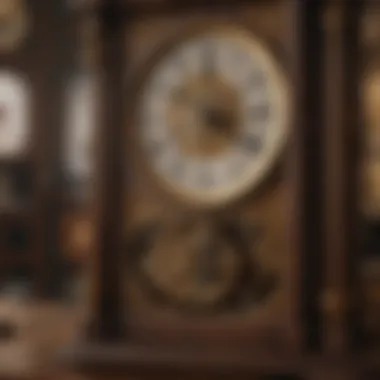Understanding the Mechanism of Pendulum Clocks


Overview of Research Topic
Brief Background and Context
Pendulum clocks are renowned for their precision and reliability in measuring time. Developed in the 17th century, they marked a significant advancement in timekeeping. The pendulum, which swings back and forth, acts as a regulator for the clock's movement. This innovative design allowed for a level of accuracy previously unattainable with earlier clock mechanisms. The genius of the pendulum clock can be attributed largely to the pioneering work of Christiaan Huygens, who fundamentally altered how societies marked the passage of time.
Importance in Current Scientific Landscape
Methodology
Research Design and Approach
The exploration into pendulum clocks combines both historical analysis and scientific inquiry. Emphasis is placed on understanding mechanical components, the physics behind pendulum systems, and the historical evolution of these devices. This multifaceted approach allows for a robust comprehension of the subject.
Data Collection Techniques
Data collection in this research involves a thorough review of historical documents, academic journals, and scientific literature. Sources such as Britannica and Wikipedia offer foundational information regarding the history and function of pendulum clocks. Additionally, observational studies of functional pendulum clocks provide practical insights into their mechanisms.
"The pendulum's ability to regulate time with high precision has influenced countless advancements in the design of subsequent clocks and timekeeping technology."
Prolusion to Pendulum Clocks
Pendulum clocks represent a significant advancement in timekeeping technology. Their introduction marked a turning point in how society measured time, influencing various aspects of everyday life. The understanding of pendulum clocks encompasses both their mechanical operation and the historical progression that led to their development. In this section, we will explore the definition and historical context of pendulum clocks, as well as their importance in the evolution of precision timekeeping.
Definition and Historical Context
A pendulum clock is a timekeeping device that utilizes a swinging pendulum to regulate its movement. The pendulum swings at a constant rate, which is primarily dictated by its length. The design of these clocks dates back to the 17th century when the Dutch scientist Christiaan Huygens invented the first effective pendulum clock in 1656. Huygens' work laid the foundation for more accurate timekeeping.
Historically, the introduction of the pendulum clock was revolutionary. Before its invention, timekeeping was less precise, relying on sundials or hourglasses. The advent of the pendulum clock allowed for accuracy within seconds, a significant improvement at the time. This accuracy became crucial for navigation, astronomy, and scientific experiments. The pendulum clock also influenced societal structures, such as the scheduling of transportation and commerce, thus shaping modern societal norms.
Significance in Timekeeping
Pendulum clocks hold an undeniable place in the history of timekeeping. Their precision altered how people perceived and utilized time. The clock's mechanism allowed for a standardized way to track hours and minutes, facilitating more synchronized societies.
The introduction of the pendulum clock had multiple benefits:
- Enhancement of Accuracy: Compared to earlier timekeeping devices, pendulum clocks could measure time with an accuracy of up to one second per day.
- Impact on Sailing and Navigation: Accurate timekeeping was essential in determining longitude at sea, an issue that sailors faced for centuries.
- Scientific Advancements: The precision of pendulum clocks enabled more accurate experimentation and observations, fostering scientific discovery during the Age of Enlightenment.
Today, although technology has evolved, the principles established in pendulum clocks remain relevant. They established benchmarks for future timekeeping devices, influencing recent innovations in both digital and mechanical clocks. Understanding their mechanism and historical significance enhances our appreciation for advancements in timekeeping technology.
Basic Principle of Pendulum Motion
The fundamental concept of pendulum motion is crucial for grasping how pendulum clocks operate. It involves understanding how the pendulum swings back and forth in a regular, predictable pattern. The simplicity of the pendulum's movements belies the complexity of the physics involved. This section will elaborate on two key elements: simple harmonic motion and the various factors affecting pendulum motion.
Concept of Simple Harmonic Motion
Simple harmonic motion (SHM) is the backbone of how a pendulum functions. In SHM, an object moves back and forth around a central point. For a pendulum, the swing is periodic, meaning it repeats itself at predictable intervals. This regularity is what enables pendulum clocks to maintain accurate time.
The restoring force acting on the pendulum is proportional to the displacement from its equilibrium position. In the case of pendulums, this force is gravity. As the pendulum swings upward, gravity pulls it back toward its lowest point. The time it takes to complete one full swing is called the period. The period of a pendulum is influenced primarily by its length and the gravitational acceleration at its location.
A mathematical expression describes this relationship:


Where:
- T is the period of the pendulum,
- L is the length of the pendulum,
- g is the acceleration due to gravity.
This equation illustrates the significance of the pendulum's length. A longer pendulum will have a longer period, while a shorter one will swing more quickly.
Factors Affecting Pendulum Motion
Several variables can influence the accuracy and regularity of a pendulum's motion. Understanding these factors is essential for anyone interested in the intricate workings of pendulum clocks. The primary considerations include:
- Length of the Pendulum: As mentioned, the length greatly affects the period. Any adjustments to the pendulum's length will result in changes in the time it takes to swing, consequently altering the clock's accuracy.
- Gravity: Variations in gravitational force, such as those experienced at different altitudes, can affect how a pendulum swings. In regions with lower gravity, the period of swing will be longer.
- Amplitude of the Swing: While ideal conditions assume small oscillations, larger swings can lead to a decrease in accuracy. At larger angles, pendulum motion is no longer simple harmonic, resulting in complexities that can affect timing.
- Air Resistance: Although usually negligible, resistance from the air can slow down the pendulum over time. This factor is usually more significant in lighter pendulums.
The balance of these factors determines the precision of a pendulum clock, emphasizing the need for meticulous engineering.
Understanding these principles is not just theoretical; they are critical in the construction and calibration of pendulum clocks. The interplay of simple harmonic motion and affecting variables lays the foundation for accurate timekeeping, showcasing the pendulum's role as a mechanical marvel.
Key Components of a Pendulum Clock
The functionality of pendulum clocks relies heavily on several key components. Understanding these parts is crucial for grasping how these timepieces have maintained their prominence in the realm of horology. Each component interacts in a precise manner, contributing to the clock's ability to provide accurate timekeeping. The significance of these components cannot be overstated, as they represent both the beauty and complexity of mechanical engineering.
The Pendulum
The pendulum is the heart of a pendulum clock. It typically consists of a weight suspended from a long rod or string. The design allows for a consistent and predictable motion. This motion is essential for maintaining a regular interval of time. The period of swing of the pendulum is determined by its length. Longer pendulums have a slower swing, whereas shorter ones move faster. This relationship between length and period is a fundamental principle of physics, and it ensures that pendulum clocks can achieve remarkable accuracy.
The mass of the pendulum bob also plays a role, but to a lesser extent. A heavy bob may provide more stability against minor disturbances. Thus, it aids in maintaining the pendulum's rhythm.
The Escapement Mechanism
The escapement mechanism serves a critical function in controlling the release of energy in a pendulum clock. Essentially, it translates the pendulum's swing into intervals of time. When the pendulum swings to one side, the escapement allows the gears to move forward, while simultaneously locking the movement when the pendulum swings to the other side. This action is vital; it creates the ticking sound associated with pendulum clocks.
There are various types of escapements, with the anchor escapement being most common in pendulum clocks. Its design allows for greater efficiency and accuracy. Without an effective escapement, the clock would lose its ability to keep consistent time, as the pendulum would simply swing freely without regulation.
The Gear Train
The gear train connects the escapement to the clock face, translating pendulum motion into the movement of the hands. It consists of a series of gears that interact with one another, functioning like a well-orchestrated ensemble. The gear ratios determine how the pendulum's oscillations affect the clock's minute and hour hands.
Each gear must be precisely calibrated to ensure the accurate functioning of the clock. If the gears are not aligned correctly, the time displayed can be significantly affected. Precision in the gear train design is essential, as it allows for the smooth movement of the clock hands and prevents any potential jamming or skipping that could lead to time inaccuracies.
The Clock Face
The clock face serves multiple purposes. It is the display area where time is visually represented. Clocks typically feature hour and minute markers, and in some instances, seconds markers as well. The most basic clock face will simply show the hour and half-hour marks. Some more elaborate designs may display additional features, such as Roman numerals.
Furthermore, the clock face is also a design element, often reflecting the craftsmanship and aesthetic of the clock. In high-end timepieces, intricate designs may include engravings, embellishments, or unique materials. The clock face does not only tell time; it can also serve as a piece of art.
A well-designed clock combines functionality with aesthetic appeal, showcasing the artistry of its creation.
Understanding these key components underscores the intricate mechanics behind pendulum clocks. Each part contributes significantly to the overall timekeeping capability of the clock, demonstrating the importance of precision in both engineering and design.
The Working Mechanism
Understanding the working mechanism of pendulum clocks is crucial for grasping how these devices achieve their remarkable precision. The pendulum acts as the central component in this mechanism, utilizing periodic motion to regulate the passage of time. The interplay of mechanical elements in a pendulum clock, particularly the pendulum, escapement, and gear train, creates a reliable system that demonstrates the principles of physics at work.


How the Pendulum Regulates Time
The pendulum, a weight suspended from a pivot, oscillates back and forth in a regular and predictable manner. This motion is governed by the laws of simple harmonic motion, where the time period—that is, the time taken for one complete oscillation—is largely influenced by the length of the pendulum and the acceleration due to gravity. A longer pendulum swings more slowly, while a shorter pendulum swings faster.
In practical application, the clock's escapement mechanism interacts with the pendulum to count the oscillations. Each swing of the pendulum allows the escapement to release a controlled amount of energy to the gear train, which drives the clock hands forward. Consequently, this process ensures that timekeeping remains consistent and accurate.
One might ask how variations in environmental conditions impact this regulation. Factors like air resistance and temperature changes can cause minor fluctuations in the pendulum's movement. Nevertheless, the fundamental mechanics of a pendulum remain constant, showcasing why this design has stood the test of time in horological technology.
Role of Gravity and Inertia
Gravity and inertia play significant roles in the function of a pendulum clock. Gravity pulls the pendulum down toward the earth, providing a restoring force that enables the oscillation. This force is essential: without it, the pendulum would not swing back after reaching its peak height. Moreover, inertia, which is the tendency of an object to resist changes in its state of motion, allows the pendulum to continue its swinging motion once initiated.
These two forces work in tandem. When the pendulum swings, gravity acts to bring it back to its resting position, while inertia keeps it moving. The relationship between the two is finely balanced; if either force were altered significantly, the accuracy of the clock would be compromised. Thus, understanding the dynamics of gravity and inertia is critical for appreciating the true elegance of pendulum clocks.
"A pendulum clock exemplifies simplicity in design but complexity in operation, relying on the harmony of natural forces to maintain time continuously."
In summary, the working mechanism of pendulum clocks reveals how effective simple designs can be in achieving precise timekeeping through the consistent regulation of motion. Recognizing the importance of the pendulum’s role, as well as the interactions between gravity and inertia, enhances our comprehension of this fascinating timekeeping technology.
Accuracy and Factors of Pendulum Clocks
Pendulum clocks are remarkable for their accuracy in timekeeping. This subsection explores the elements that contribute to their precision and the factors that can hinder their performance. Understanding these aspects is essential for appreciating the complexities involved in the operation of pendulum clocks. Modern advancements in technology continually emphasize the relevance of accurate time measurement, and pendulum clocks serve as a foundational example of such mechanisms.
Effects of Temperature and Humidity
Temperature and humidity significantly affect the performance of pendulum clocks. Temperature changes can lead to the expansion or contraction of materials used in the clock's construction. For instance, a pendulum made of brass may expand in higher temperatures, potentially altering its length. A longer pendulum will swing more slowly, causing the clock to lose time. Conversely, cooler temperatures may contract the material, making the pendulum shorter and resulting in faster oscillations.
Humidity also plays a vital role. High levels of moisture in the environment can lead to changes in the wood used in the clock's casing, which can warp or swell. This affects not only the pendulum but also the accuracy of the escapement mechanism. Therefore, maintaining a stable environment is crucial for ensuring optimal performance.
Pendulum Length and Clock Accuracy
The length of the pendulum is a critical factor in determining the clock's accuracy. According to the principles of physics, specifically the formula for the period of a simple pendulum, there is a direct relationship between the length of the pendulum and the time it takes to complete a full swing. This relationship is expressed as follows:
Where:
- T = period of the pendulum (time for one full swing)
- L = length of the pendulum
- g = acceleration due to gravity
As the length increases, the time period also increases. In practical terms, this means that longer pendulums oscillate more slowly compared to shorter ones, making them better suited for timekeeping at extended intervals. Adjusting the pendulum length allows clockmakers to fine-tune clock accuracy, and small adjustments can significantly impact performance.
The intricate balance between these factors is pivotal for maintaining accuracy in pendulum clocks. In unusual environments or conditions, even minor deviations can escalate into significant discrepancies in timekeeping. Consequently, understanding how temperature, humidity, and pendulum length influence clock accuracy is essential for both the conservation of historical clocks and the design of modern timekeeping devices.
Modern Developments in Pendulum Clocks
The evolution of pendulum clocks has taken intriguing turns as technology advances. Such modern developments represent a significant leap in clock accuracy and functionality. These changes not only showcase human ingenuity but also emphasize the relevance of pendulum clocks in today's world. The examination of digital versus mechanical timing, and the emergence of hybrid mechanisms, highlights how traditional designs are being adapted to meet contemporary needs.
Digital vs. Mechanical Timing
The contrast between digital and mechanical timing systems is striking. Digital clocks utilize electronic components, allowing them to be more precise. They display time numerically, often with added features like alarms or timers. In contrast, pendulum clocks, known for their mechanical simplicity, represent time in a more classical sense.
The precision of digital clocks raises questions about the future of mechanical designs. Several people prefer pendulum clocks for their aesthetic and historical value. Mechanical clocks like those with pendulums are deeply rooted in tradition. They represent craftsmanship and engineering mastery. Their ability to operate without batteries appeals to enthusiasts seeking sustainability and longevity.
While digital clocks are often more accurate, many modern pendulum clocks are being built with improved materials. This facilitates better performance and adaptation to modern standards. Additionally, advancements such as quartz technology have influenced pendulum clocks. Some manufacturers have incorporated quartz oscillators into pendulum designs, achieving remarkable accuracy while still maintaining the mechanical appeal of the pendulum.


Hybrid Mechanisms
Hybrid mechanisms combine traditional pendulum designs with modern technology. Such clocks can feature both mechanical and electronic components. For instance, a pendulum clock may still operate via gravitational pull, but utilize digital displays for timekeeping. This allows flexibility and innovation in clock design while honoring traditional mechanics.
Here are some key advantages of hybrid mechanisms:
- Enhanced Accuracy: By integrating electronic timing elements, hybrids achieve improved precision.
- Aesthetic Appeal: They maintain the beauty of pendulum movements but add modern functionality.
- Versatility: Hybrid mechanisms allow creators to blend styles, attracting diverse audiences.
An example of a hybrid clock can be seen in designs produced by certain artisans who build clocks that emphasize both aesthetics and functionality. These innovations often lead to a resurgence of interest in pendulum timepieces, blending the old with the new. It is pertinent to note that the rise of technology does not erase the charm of traditional clock designs but instead facilitates their evolution.
"As technology evolves, so too can the mechanisms behind our timekeeping devices—allowing us to honor tradition while embracing innovation."
Applications and Cultural Impact
The applications and cultural impact of pendulum clocks offer significant insights into their relevance and influence over time. Pendulum clocks not only serve as timekeeping devices but also have found their place in educational contexts and artistic expressions. Their design and mechanism have influenced various fields, from science to literature, showcasing the dual nature of their contribution to both functional and cultural narratives.
In Science and Education
Pendulum clocks are often used as practical examples in educational settings to illustrate principles of physics. Their operation effectively demonstrates concepts such as periodic motion, gravitational force, and harmonic oscillation. This makes the pendulum a tangible subject for students ranging from young learners to advanced scholars.
Students studying mechanics can conduct experiments using pendulum clocks to observe how different lengths of pendulums affect timing. By adjusting the variables, they can derive formulas and principles relevant to their studies. This hands-on approach aids in deepening their understanding of theoretical concepts while showcasing real-world applications.
Furthermore, pendulum clocks serve educational purposes beyond mere mechanics. They highlight historical advancements in technology and design, providing a context for discussions about scientific progress through the ages. The evolution of timing devices from simple sundials to complex mechanical clocks fosters critical thinking about innovation, societal needs, and the pursuit of precision.
Representation in Art and Literature
Pendulum clocks have transcended their functional role as mere timekeepers to become prominent symbols in art and literature. Their intricate designs and rhythmic movements have inspired various art forms, reflecting the blend of beauty and precision.
In literature, pendulum clocks often symbolize the passage of time, the inevitability of fate, or the complexity of existence. Authors may use these clocks as motifs to convey deeper philosophical insights or an exploration of human consciousness. The rhythm of a pendulum can represent the order within chaos, mirroring existential themes in works of fiction.
Artists, too, have found inspiration in the clock's mechanical beauty. Works of art featuring pendulum clocks often encapsulate a sense of nostalgia and the fleeting nature of time. This representation underscores a cultural appreciation for craftsmanship and the intricate interplay between time, history, and human experience.
"The pendulum clock is more than a device; it embodies an era of innovation and thought, weaving its way through the realms of science, art, and philosophy."
In summary, pendulum clocks possess a multifaceted significance that extends beyond their mechanical functions. Their applications in science enhance educational experiences, while their cultural representations in art and literature invite deeper reflections about time and existence. Understanding these dimensions enriches our views on the role pendulum clocks play in both historical context and modern society.
End
The conclusion of this article serves as a pivotal element, tying together the varied themes and insights regarding the mechanism of pendulum clocks. Understanding how these timekeeping devices operate is not merely academic; it illuminates essential principles about mechanical engineering, physics, and the history of technology.
Lessons Learned from Pendulum Clocks
From examining pendulum clocks, several lessons emerge. First, the importance of precision in mechanical design cannot be overstated. Each component, from the pendulum to the escapement, plays a crucial role in achieving accurate timekeeping. These clocks demonstrate that small changes, like variations in pendulum length or environmental conditions, can lead to significant impacts on performance. This highlights the necessity for meticulous calibration.
Second, pendulum clocks exemplify the relationship between theory and practical application. The concept of simple harmonic motion, while rooted in physics, finds real-world utility in these clocks. This intersection of theory and practice is a valuable insight for anyone involved in engineering or timekeeping technology.
Lastly, the historical and cultural significance of pendulum clocks teaches us about innovation's role in societal progress. These clocks were not just timekeepers but also symbols of the Enlightenment, showcasing human ingenuity and our quest for knowledge. Thus, their study extends beyond mechanics into realms of philosophy and social history.
Future of Timing Mechanisms
Looking ahead, the future of timing mechanisms is poised for significant evolution. While pendulum clocks remain iconic, advancements in technology lead us towards more precise methods of keeping time. Digital clocks and atomic timekeeping devices are already setting new standards for accuracy.
However, the basic principles of the pendulum’s mechanical design still resonate in modern engineering. Hybrid designs that incorporate digital technology alongside traditional mechanics could emerge, combining the charm of pendulum functionality with cutting-edge precision.
Furthermore, as the world increasingly values sustainability and energy efficiency, the development of energy-conserving timing mechanisms will likely take precedence. Understanding traditional mechanisms like pendulum clocks can inspire innovative designs that respect these principles, ensuring they continue to remain relevant.
In summary, the exploration of pendulum clocks offers valuable lessons about precision, design, and historical significance. As we look to the future, maintaining an appreciation for these mechanical wonders may guide the development of next-generation timekeeping devices.



